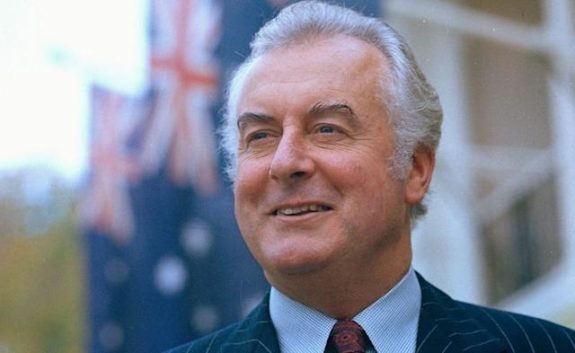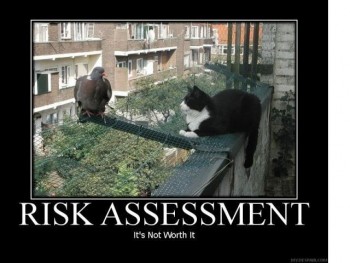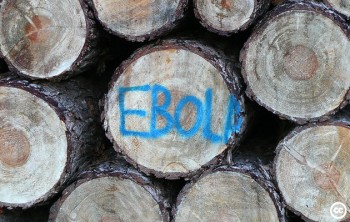Each generation has its historic moments, its touchstone memories. I grew up in the 1980s, and my touchstones were the Ethiopian famine, Masters of the Universe and Transformers toys, and Ebola. For all that Ebola was a virulent disease, the outbreak was in a faraway land and affected only a few hundred people. It was horrible for those people, of course, but it’s difficult to see now why an obscure virus outbreak in third-world countries became the subject of teenage nightmares. Breathless news reports gave the unwarranted impression that the scourge of a horrible and uncurable disease was about to sweep the world and bring humanity to its knees.
It never happened, of course. Due to effective healthcare and isolation procedures, Ebola was brought back under control, its outbreak cleared, and the disease eliminated from human population centres.
In the years that have followed, the odd case of Ebola has surfaced. Few cases could be classified as “outbreaks”. Ebola has remained a remote threat and it fell out of the consciousness of the public.
Recent weeks have seen Ebola back in the news, with a far more serious outbreak than anything before in history currently spreading in western African nations. Today’s news media are full of breathless reports on a wildfire disease, out of control, an epidemic. And far more than in the 1980s, what starts as breathless reporting in the mainstream media easily evolves into sheer panic-stricken hysteria in some portions of the internet. It’s important to be aware of the facts, the real risks, and what realistic risk, if any, there is to western populations.
So what is Ebola, why is this outbreak significant, and is there really a risk of a global pandemic that will kill us all?
What is Ebola?
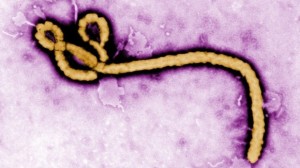 “The Ebola virus” is a term applied to a group of related viruses, infectious viral diseases that cause a deadly kind of haemorrhagic fever in mammals. It’s a cruel disease and a frightening one; the symptoms of advanced Ebola infection are both hideous and highly dangerous.
“The Ebola virus” is a term applied to a group of related viruses, infectious viral diseases that cause a deadly kind of haemorrhagic fever in mammals. It’s a cruel disease and a frightening one; the symptoms of advanced Ebola infection are both hideous and highly dangerous.
The virus has a long incubation period – the time between infection and showing the first symptoms – of between one and three weeks. During the incubation period sufferers have no warning of the disease and its progress, and they are not infectious to those around them.
When they appear, early symptoms can seem like a mild influenza, including fever, muscle weakness, sore throat and headaches. The classical symptoms of Ebola follow later: the virus attacks the body’s internal organs, particularly the kidneys and liver and the digestive tract. Symptoms include vomiting and diarrhea. Another effect of the virus is to impair the ability of blood to clot, leading to internal and external bleeding. In the advanced stages, sufferers can bleed from all of the body’s orifices.
Ebola is one of the deadliest viruses on Earth; fatality rates for the different strains vary between approximately 50 and 90 percent. There is no cure. The current outbreak in Africa has a fatality rate of about 60 percent – and that’s with medical intervention.
How is Ebola transmitted?
The virus is highly infectious with contact to the sufferer’s body fluids. This includes blood, urine, faeces, vomit or even sweat. A patient is not contagious until he or she starts showing signs of the disease.
Ebola is not “airborne”: you cannot catch Ebola by breathing the same air as an infected patient. There has been one documented case of the virus spreading through the air: in 2012 a study involving pigs and monkeys resulted in infection of the monkeys from infected pigs without any direct contact. However, Ebola infects humans and pigs differently. In pigs Ebola concentrates in the lungs, causing infected pigs to sneeze and splutter much more than humans, where the virus principally attacks the liver. Human sufferers do sneeze and cough infectious droplets that can travel short distances through the air, but this form of infection would require close proximity. It is theoretically possible to catch Ebola from a large droplet but so far there is no evidence to point to aerosolisation.
How do you treat it
Ebola is a tropical disease that is thought to be carried in the wild by bats. There has been little exposure of this virulent infection in human communities, and thus there is little to no immunity already in the human population. When Ebola infects a human population, most people are extremely susceptible to it upon exposure. Despite intensive research over decades, there is currently no vaccination or prevention method available for Ebola. The only way to ensure you don’t catch it is to avoid contact with infectious materials, which can be difficult when the late stage of the disease results in significant amounts of bleeding and other fluid discharge.
It’s important to note also that you can’t cure viruses. A virus is not like a bacterium; bacteria are self-contained organisms that invade and infest a host, but remain separate to it. Viruses have no independent existence outside of a host. Viruses are, in effect, strings of DNA, and they act by embedding themselves into the DNA of the infected creature. Upon infecting a cell’s DNA, a typical virus will prevent that cell from acting normally and instead turn its machinery to churning out billions more copies of the virus, eventually breaking the cell open to infect those around it.
The problem is that, like a cancer, a virus-infected cell still looks like it belongs to the body. An infected cell cannot be returned to its pre-infection state; the only way forward is to kill that cell. Any “cure” needs to be able to identify infected cells and kill them while leaving uninfected cells intact. Human medical science is typically not very good at doing this; in some cases the effects of viral infection can make a cell susceptible to specific drugs, but there are as yet no drugs on the market that can specifically target Ebola-infected cells.
Where human science fails, the immune system normally excels. Identifying infected cells and destroying them is its sole function. But Ebola virus is also known to attack and pervert immune system cells, and even to use these cells to carry itself throughout the sufferer’s body. With the virus wreaking havoc on the body’s organs, causing massive internal bleeding and constraining the immune system’s activity, the infected host will almost certainly die well before its immune system can fight off the infection.
Given enough time, for some people, the body can rid itself of an Ebola infection. Left to its own devices, the disease is virulent enough to kill most people before their immune system can do the job, so treatment for Ebola is, simply speaking, to treat the symptoms, and to keep the victim alive long enough for their own immune system to let them recover. If the victim was healthy with a robust immune system prior to infection, the chances of survival increase.
Keeping patients hydrated and providing them with the nutrients they and their immune system need is the accepted treatment for this disease. In the case of Ebola this must be done whilst avoiding contact with infectious materials and isolating the patient from family, friends and the public. Even with full medical support, in the current outbreak, the chances of survival are only about 40%.
The current outbreak
Ebola was first identified in 1976, and was named for the region in Africa (the Ebola River) in which it emerged. From that time until the current outbreak, there have been about 1700 recorded cases of Ebola in humans. The current outbreak has so far (as of 22nd August 2014) killed well over 1400 people and infected over 2600.
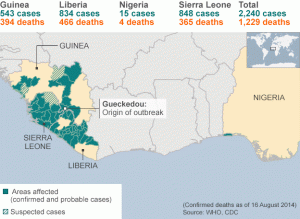
(Image source: BBC)
The current outbreak affects a region of Western Africa overlapping the borders of Guinea, Sierra Leone and Liberia. Due to the virus’s highly infectious nature and its long incubation period, there have been many cases of travellers from these areas bringing the disease to other nations. Most significantly affected in this way are other African nations such as Nigeria and Congo, but cases have been identified as far distant as Ireland.
Unofficially, it is likely that the infection rates in Africa could be MUCH higher than the official numbers. The actual numbers are impossible to quantify, as many cases have not been laboratory confirmed and the disease is officially out of control. With a long asymptomatic incubation period, it is likely that many people are infected without yet showing symptoms. Many cases are likely to be in “shadow zones”, outside of officially monitored areas and unrecorded by medical authorities. In addition, there are currently outbreaks of Ebola-like disease in other neighboring countries not yet officially declared a part of this outbreak.
Regardless of the numbers of infected, the UN states that over a million people are affected either directly or indirectly by this outbreak.
Different strains of Ebola have different levels of lethality. The current outbreak is trending at about 60%: six of every ten people diagnosed with the virus (and under medical care) are dying despite best medical efforts.
Why it’s a crisis
The keys to dealing with an outbreak of Ebola are halting its spread and treating its victims to keep as many alive as possible. In the areas of West Africa, in Sierra Leone, Liberia, Guinea and Nigeria, both of these are proving problematic.
Halting the spread of the disease entails rapidly identifying and isolating all sufferers, quarantining those who might have come into contact with them, and educating populations about behaviours that contribute to the virus’s spread. Attempts to do this are ongoing but are running into difficulties due to human nature and community practices in these regions. Patients, and their families, have been seen to behave in ways that are harmful to themselves and to others. In some cases, infected patients have fled hospital, or avoided going to hospital in the first place, for fear of being restrained there to die. Families hide their symptomatic relatives to prevent them being isolated. Local burial customs further complicate matters, with some documented cases of people being infected by touching the departed during preparation of the body or during the funeral service.
Treatment, too, has its problems. The affected countries already have healthcare systems that struggle to support their populations. In many cases, healthcare in rural areas is nonexistent, and the disease has now spread into major urban centres so the lion’s share of medical resources is spent there. Despite Ebola being endemic to Africa, previous outbreaks have been in the centre of the continent, and West Africa was neither experienced in nor prepared for an infection of this type. As a result, we have seen a high number of healthcare workers succumb to the disease as response efforts scaled up, leading to a loss of expertise and resources.
The other enemy is fear. In many areas, deliveries of goods (including medicine, food and water) have ceased as couriers and drivers are unwilling to enter the infected areas. This simply contributes to the breakdown of social order and the environment of fear, and hampers those whose goal is to control the infection and help those affected.
What’s being done
It is clear that this outbreak is well beyond the capabilities of the affected nations to handle on their own. Even with contribution by the World Health Organisation and the CDC, the epidemic is currently classed as “out of control”. Medical charities such as Médecins Sans Frontières (Doctors Without Borders) have deployed thousands of staff to run Ebola clinics to supplement overwhelmed healthcare systems. The WHO is providing expertise and leadership, although some have accused it of reacting far too slowly.
In the face of the unprecedented scale of this outbreak, the usual safeguards on novel treatments have been relaxed. Antiviral drugs such as ZMapp are being provided for live-action trials on the understanding that survival is unlikely with or without treatment; even though such treatments might be untested and theoretically could in themselves be harmful, the thought is that someone who’s already dying of Ebola is going to be willing to take the risks. While several people treated with ZMapp have survived, some have not, and it it far too early to say whether ZMapp or other drugs currently in testing are having any positive effects at all.
The imperative to constrain the spread of this virus has led to the imposition of a zone sanitaire: the affected regions are being closed off, with the only egress being via controlled medical checkpoints. Most international airlines have already ceased flights to and from affected areas. At the same time, entry points across the world are on high alert, with airline staff, port and dock authorities and airports being on the lookout for any travellers from affected regions showing any symptomology. This may not be enough to completely prevent the disease’s spread but should severely constrain it.
It’s important to note, finally, that even if a case of Ebola does arrive in Australia or the US – say an infected traveller arriving before they become symptomatic – the uncontrolled spread of the disease is far less likely. In the western world we already impose standards of hygiene that protect against transmission. We generally don’t come into contact with other people’s blood, urine or faeces in daily life. By the time a sufferer becomes highly infectious, they are also highly symptomatic and likely to be under appropriate medical care. We can be sure also that appropriate quarantine and control measures would be rapidly brought to bear.
Learnings for us
There are several key factors in the current Ebola scare. The first is that the current outbreak of Ebola is unlikely to become a pandemic and we, in civilised Australia, should be safe from its immediate effects. Breathless reporting of the risks to global civilisation are overstating the infectiousness and risk of this disease. Ebola may well bring African nations to their knees, but by virtue of distance and a sophisticated healthcare system and high standards of hygiene, any cases in the western world will be rapidly contained.
It’s not all good news though. We live in a global world. Conditions that affect remote third world countries nonetheless have an effect here. Our healthcare systems are on high alert for this disease and, belatedly, the western world is pouring money, personnel and resources into helping their poorer neighbours in Africa. Globalisation has had many beneficial outcomes for the western world – particularly in the availability of cheap labour and cheap goods – but it has also thrown into sharp relief the inequalities between nations.
Ebola is a zoonotic disease. Like Hendra, swine flu, rabies and SARS, a form of the virus lives in wild animal populations, but is capable of being passed to humans on exposure. The virus is not new. What is new is its introduction into human populations, and this is typically the result of increasing encroachment of human civilisation into previously wilderness areas. The unfortunate fact is that most of this encroachment, and thus the initial outbreaks of many of these diseases, occurs in third world countries with low socio-economic conditions.
The rise of new human-infectious diseases from zoonotic sources is driven by the need of poor people in Africa, in South America, and in Asia, to support themselves with a continual push into wilderness areas. Deforestation across the world is accelerating rather than slowing. As countries are progressively deforested, native wildlife is displaced, with terrible consequences for biodiversity and ecosystems. The increased interaction between humans (and domesticated animals) and wildlife which might carry novel viruses such as Ebola means that the introduction of new diseases is not likely to end any time soon. In bats, a particular virus might be relatively harmless, as wild populations have developed immunity to it over the course of millenia; but for humans, who have never encountered it, this new virus can be devastating.
We are fortunate insofar as the human-infectious strains of Ebola are not airborne. (One known strain of Ebola is at least somewhat airborne, but this strain is not harmful to humans. “By some genetic fluke, the same mutation that rendered Ebola Reston airborne apparently also left it harmless to humans.” We dodged a bullet with that case.)
It is not beyond the bounds of consideration that a new virus will be introduced to the teeming human masses in a third-world country in the near future, a virus with the deadly consequences of Ebola but the ease of transmission of an influenza. This is the stuff of fiction – for example, Michael Crichton’s The Andromeda Strain, the movies Outbreak and Contagion, Richard Preston’s The Hot Zone. But how we would deal with such an outbreak is the subject of deadly serious consideration by epidemiologists and governments.
The long-term learning is that no nation is an island. The inequality of nations should not be allowed to continue. As long as there are impoverished populations in impoverished nations, desperately levelling their jungles at a time when the world desperately needs those jungles to be maintained, the globe will remain at risk of novel zoonotic diseases, and we may not be so fortunate next time.
Like what we do at The AIMN?
You’ll like it even more knowing that your donation will help us to keep up the good fight.
Chuck in a few bucks and see just how far it goes!
Your contribution to help with the running costs of this site will be gratefully accepted.
You can donate through PayPal or credit card via the button below, or donate via bank transfer: BSB: 062500; A/c no: 10495969

